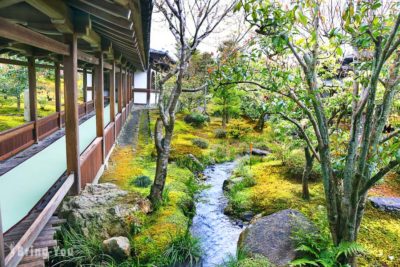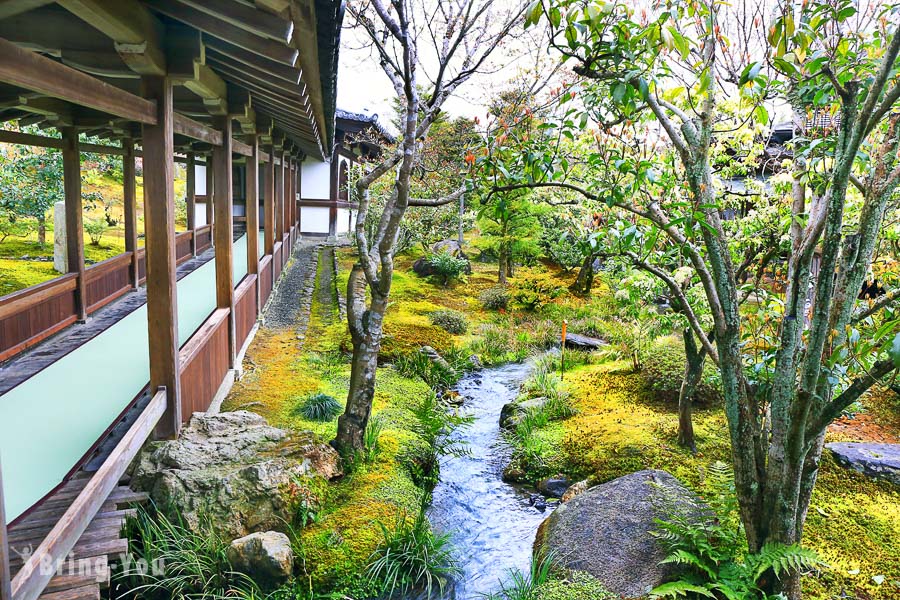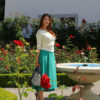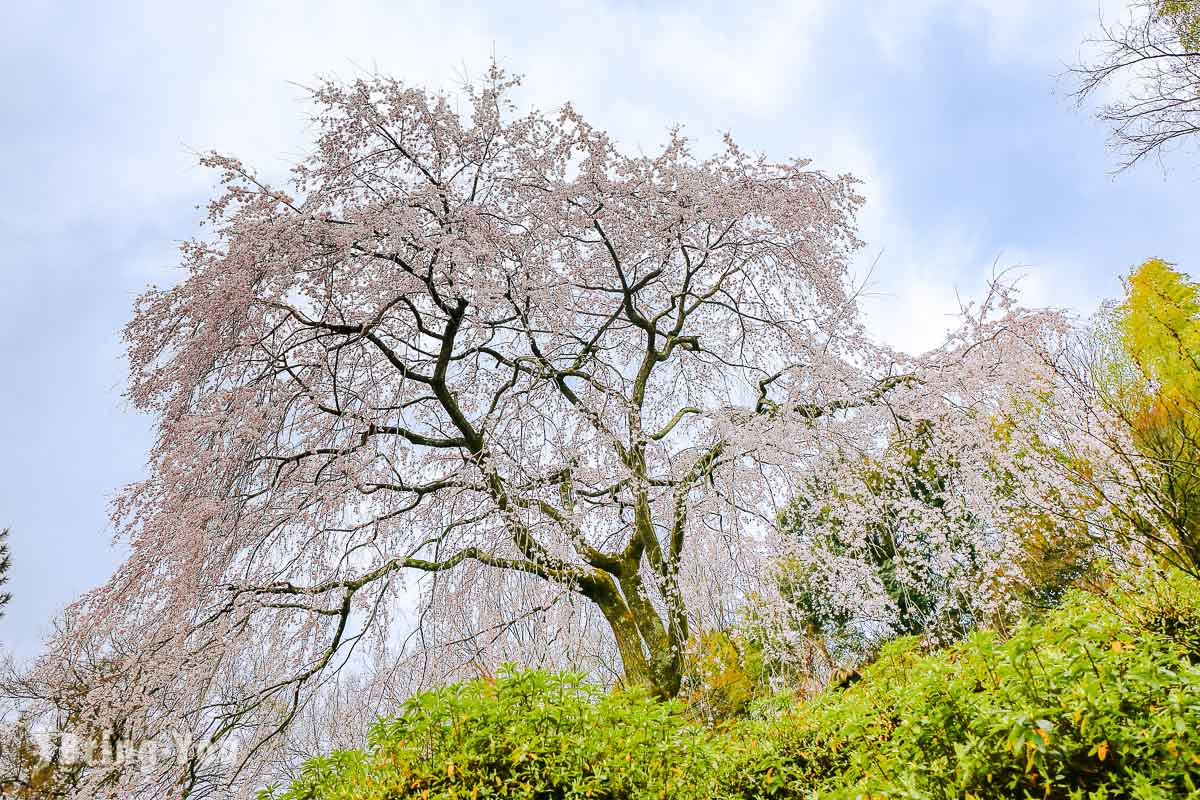
In this article, Piaor will introduce to you the famous cherry blossom viewing spot in Arashiyama – Tenryuji Temple! Built in 1339, Tenryuji Temple was originally founded by Ashikaga Takauji to pray for the peace of Emperor Go-Daigo. Zen master Muso Soseki was the founding ancestor who opened the temple. In the end of Heisei 6, it was registered as a World Cultural Heritage Site. It is suitable for viewing plum blossoms, cherry blossoms, maple leaves, and scenery. In late February, the elegant plum blossoms bloom in red and white, which is intoxicating! The weeping cherry blossoms that bloom early in spring are breathtaking, giving people a stunning visual experience from a high vantage point!
🌸 More Kyoto Cherry Blossom Viewing Spots:【Kyoto Cherry Blossom Travel Guide】Must-Visit Cherry Blossom Viewing Spots in Kyoto
Transportation to Tenryu-ji Temple
- Address: 68 Sagatenryuji-Mambonohana Babacho, Ukyo-ku, Kyoto
- Opening hours: 3/21~10/20: 8:30~17:30 (last admission at 17:00), 10/21~3/20: 8:30~17:00 (last admission at 16:30), the main hall is only open to the public on weekends and holidays
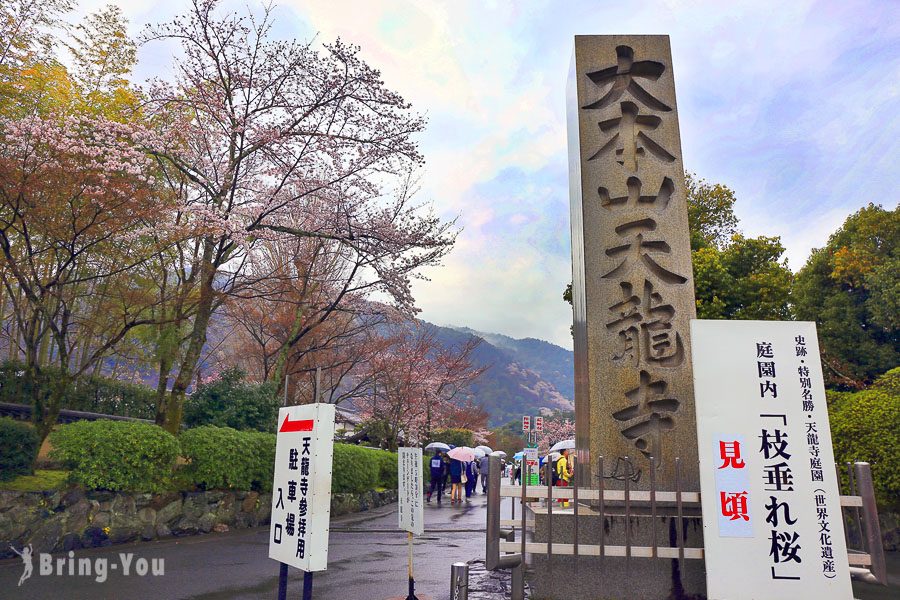
Getting to Tenryu-ji Temple is very simple. It is located just across from the Keifuku Electric Railroad “Arashiyama Station”. When you exit the station, head towards the Arashiyama Main Street and follow the signs for 2 minutes. You will see the main entrance of Tenryu-ji Temple, which is a large building. For other transportation details such as taking a bus or the JR or Hankyu trains, please see below:
If you’re still unsure about transportation in Arashiyama, check out this article: 【Kyoto Arashiyama Transportation】All the ways to get to Arashiyama for a day trip
Take a train from Osaka or Kyoto:
- Take the Keifuku Electric Railroad Arashiyama Line and get off at “Arashiyama Station”
- Take the JR Sagano Line and walk for about 15 minutes after getting off at “Saga Arashiyama Station”
- Take the Hankyu Railway and walk for about 15 minutes after getting off at “Arashiyama Station”
Take a bus from Kyoto:
- Take Kyoto City Bus 11, 28, or 93 and get off at “Arashiyama Tenryuji-mae” stop
- Take Kyoto City Bus 61, 72, or 83 and get off at “Keifuku Arashiyama Station-mae” stop
Introduction to Tenryu-ji Temple Tickets
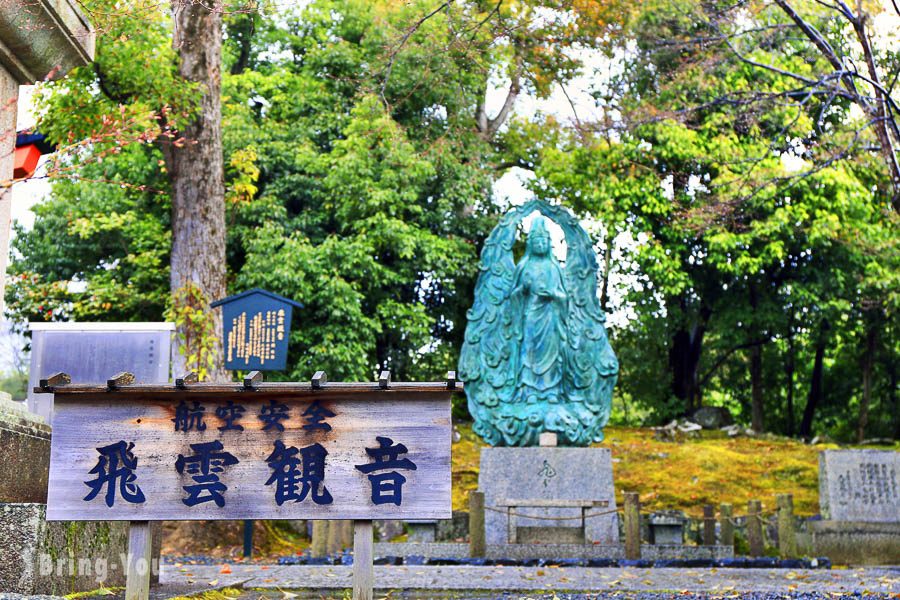
- Garden (Cao Yuan Chi, Bai Hua Yuan) admission fee: 500 yen, elementary and middle school students: 300 yen
- Visit to various halls (Da Fang Zhai Room, Shu Yuan, Duo Bao Dian): 300 yen in addition to garden admission fee
- Hall of Dharma: 500 yen
There are many attractions to visit within Tenryu-ji Temple, and tickets are divided into three areas: “Garden (Sogenchi Pond, Hyakkaen Garden)”, “Visiting the Halls (Daihonzan, Shoin, Tahoto)”, and “Hatto (Unryu-zu)”. If you only want to enjoy the cherry blossoms and don’t want to enter every area, you can focus on the most essential “Garden (Sogenchi Pond, Hyakkaen Garden)”. However, because the ticket purchase location and pricing are a bit complicated, I have listed them separately below for clarity:
Garden (Caoyuan Pond and Baihua Garden) Admission Ticket
Visitors can take a stroll in the outdoor spaces of Cao Yuan Chi Garden and Bai Hua Yuan outside the Abbot’s Chamber (Main Hall). Tickets can be purchased at the entrance ticket booth of the garden and the north gate ticket booth of the bamboo forest path for 500 yen.
Visiting Various Halls (Main Abbot’s Room, Study Hall, Hall of Treasures)
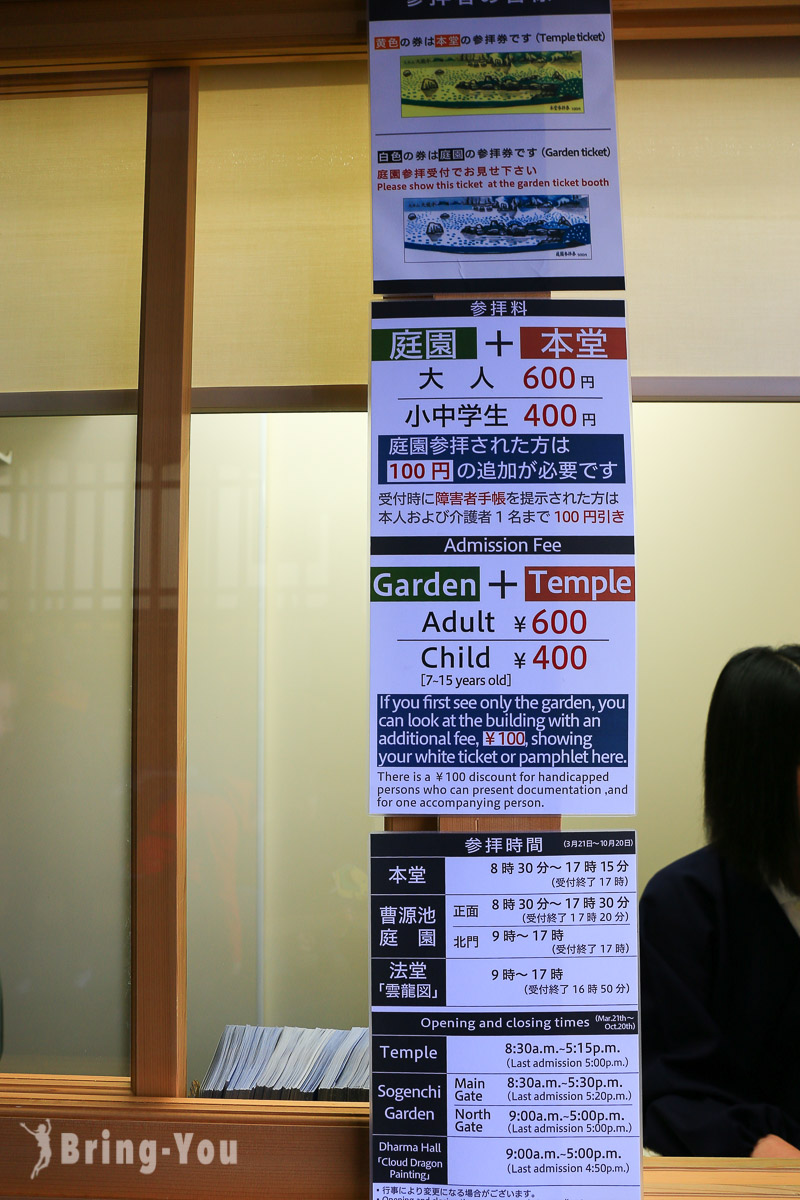
You cannot purchase tickets for visiting individual halls separately. You need to purchase tickets together with the garden, so the cost is the garden fee plus 300 yen. However, when I went there, there was a combined ticket for the garden and the main hall (Honzon-do) available for sale. If you visit the garden first and suddenly want to visit the main hall, you can also show your garden ticket and pay extra to enter the main hall. Tickets for visiting the halls are sold at the ticket office in the temple office (Kuri).
The main purpose of visiting the various halls is to take a stroll along the eaves of the main hall and enjoy the scenery of the Cao Yuan Chi Garden, as well as to visit the indoor areas. However, I feel that the garden scenery is not as beautiful as directly visiting the Cao Yuan Chi Garden area.
Temple Hall Ticket
The Fadang Hall is where you can see the “Cloud Dragon Painting”. It is only open on weekends, national holidays, and during the spring and autumn seasons. The admission fee is 500 yen and the hall closes relatively early, with the last entry at 4:20 pm.
Visiting Suggestions for Tenryu-ji Temple
If you plan to stay for only half an hour to an hour and just want to enjoy the cherry blossoms during the cherry blossom season, you can simply buy a ticket for the garden (Cao Yuan Chi・Bai Hua Yuan), spend an hour walking around outdoors and taking photos of the cherry blossoms. If you want to carefully visit Tenryu-ji Temple, appreciate this world cultural heritage site, and see the Dharma image, etc., you should buy a ticket for the various halls, which includes the garden. You can visit the indoor areas such as the Daitokuji room, the Kura, and the Tahoto-den for about 45 minutes, and then go outside to take photos of the garden.
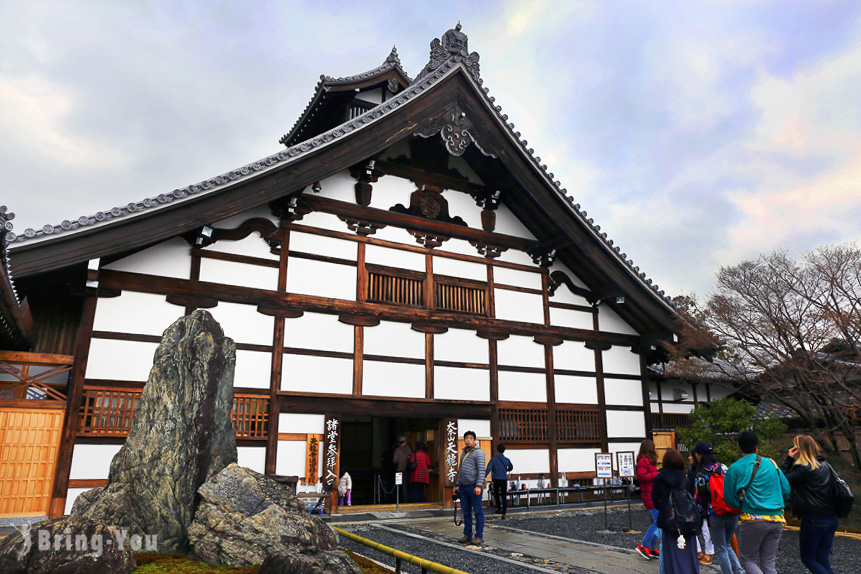
This time, I entered Tenryu-ji Temple from the entrance diagonally across from Arashiyama Station on the Keifuku Electric Railroad Arashiyama Line. I went directly to the ticket office in the Shodokura (temple office) and purchased a ticket for the garden and main hall. You can choose to visit the indoor main hall first or the outdoor garden first. I decided to take advantage of the break in the rain and explore the outdoor sights first. The following is my visiting route.
Abbot (Viewing Outside the Hall)
The first area to visit is the garden, which can be freely explored with a garden ticket. From here, you can admire the Abbot’s Quarters, which is composed of the large Abbot’s Quarters built in 1899 and the small Abbot’s Quarters built in 1924. The large Abbot’s Quarters has six rooms, with three inside and three outside, all in the shape of an abbot’s quarters. The surrounding layout is designed with a cloister, making it the largest building in Tenryu-ji Temple. The seated statue of Shakyamuni Buddha inside the large Abbot’s Quarters is an important cultural property of Japan and the oldest Buddha statue enshrined in Tenryu-ji Temple. Despite suffering from multiple fires, Tenryu-ji Temple has always been miraculously spared and remained unscathed, making it a miracle.
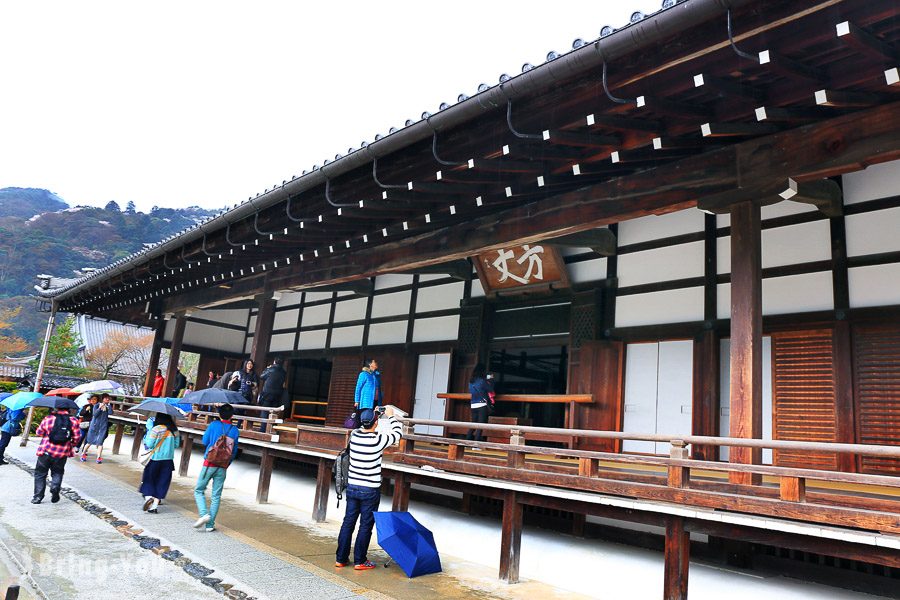
Next to the Dafangzhai is the Xiaofangzhai, which is a study with multiple rooms for receiving guests and conducting various activities and Buddhist ceremonies. Behind the Fangzhai is the “Duobao Hall” and “Baihuayuan,” which have the most cherry blossoms.
【Cherry Blossom Viewing Spot】Cao Yuan Chi Garden (Viewing Outside the Hall)
The most beautiful part of the garden is the “Cao Yuan Chi Garden”. This is a famous garden within the famous Tianlong Temple, located to the west of the main hall. The garden features a central pond and a meandering layout. It is prohibited to use tripods here, so please be aware.
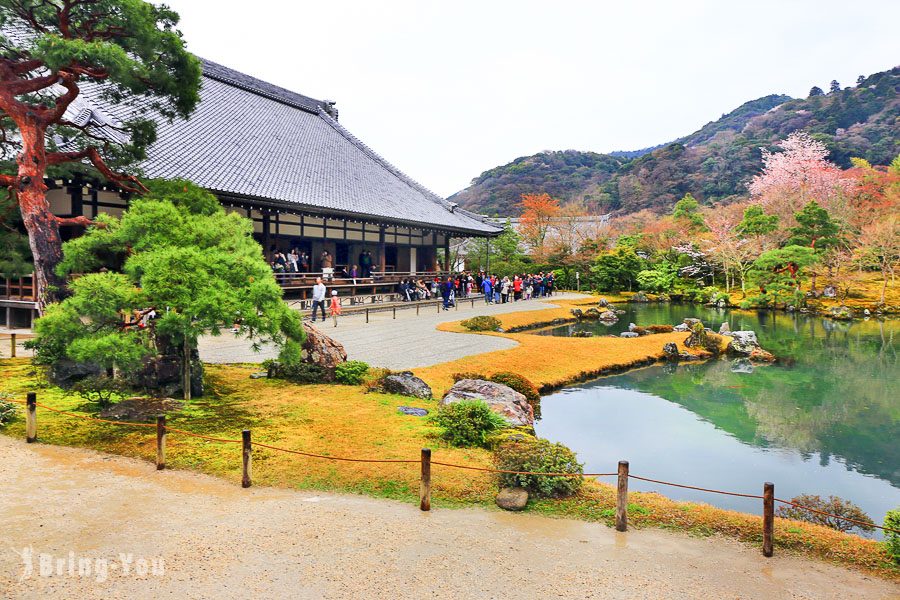
Looking from the direction of the Dafangzhai, there are two huge rocks in the center of the Cao Yuan Pond, symbolizing the “Dragon Gate Waterfall” and the stone group such as the stone bridge, which represents the carp’s struggle to swim upstream. What is rare and precious is that all the buildings in Tenryu-ji Temple were rebuilt after the Meiji era in Japan, and only the Cao Yuan Pond garden retains the state and completeness of its original creation. Therefore, it was the first to be designated as a special historic site in Japan.
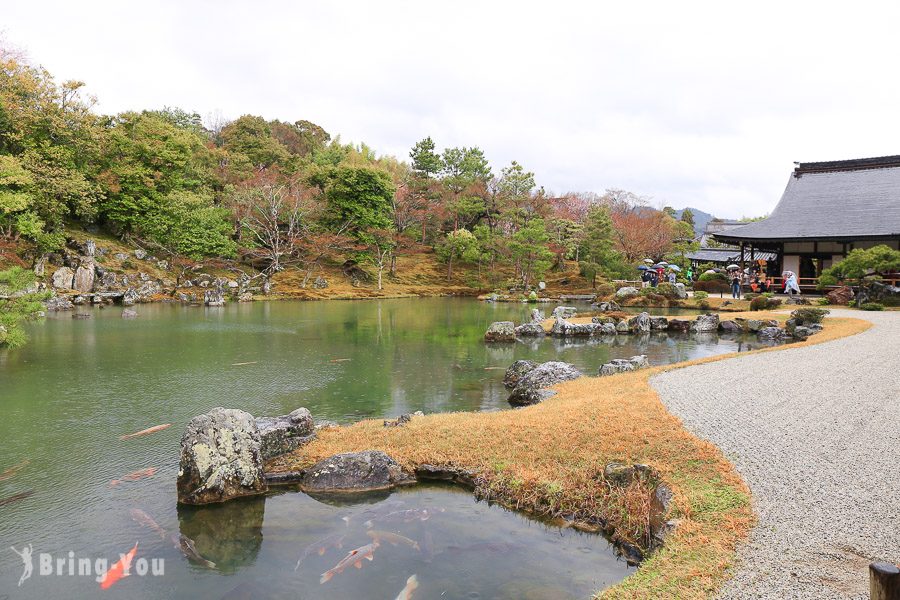
▼ The background is the stunning Caoyuanchi Garden in Arashiyama Mountain.
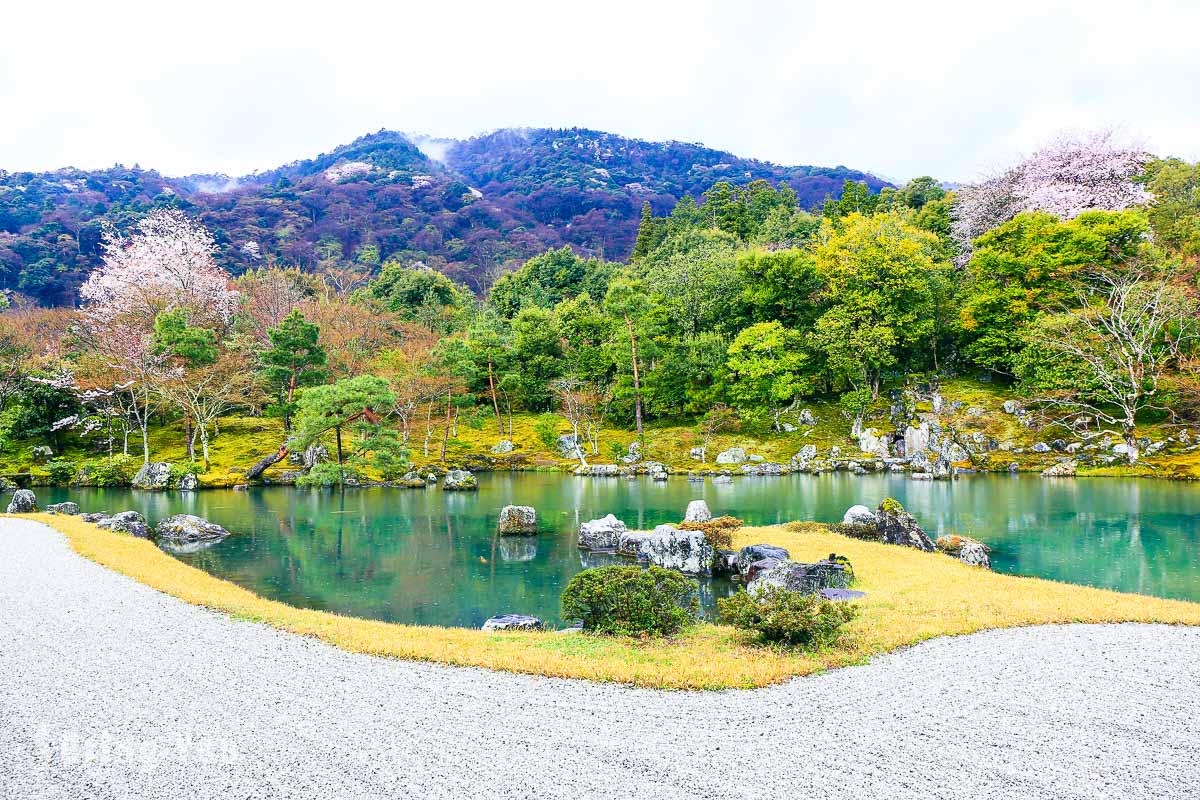
【Cherry Blossom Viewing Spot】Baihua Garden
Next is the “Baihua Garden” that can also be visited with the garden ticket. It is also the place with the most cherry blossoms in Tenryu-ji Temple, located behind the Tahoto Pagoda. Baihua Garden was established in 1983 together with the completion of the north gate of Tenryu-ji Temple.
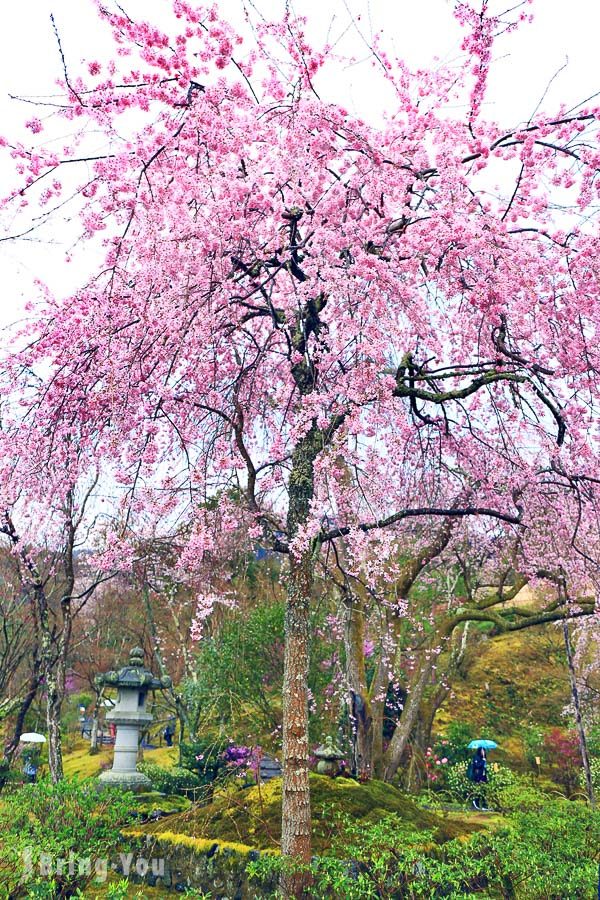
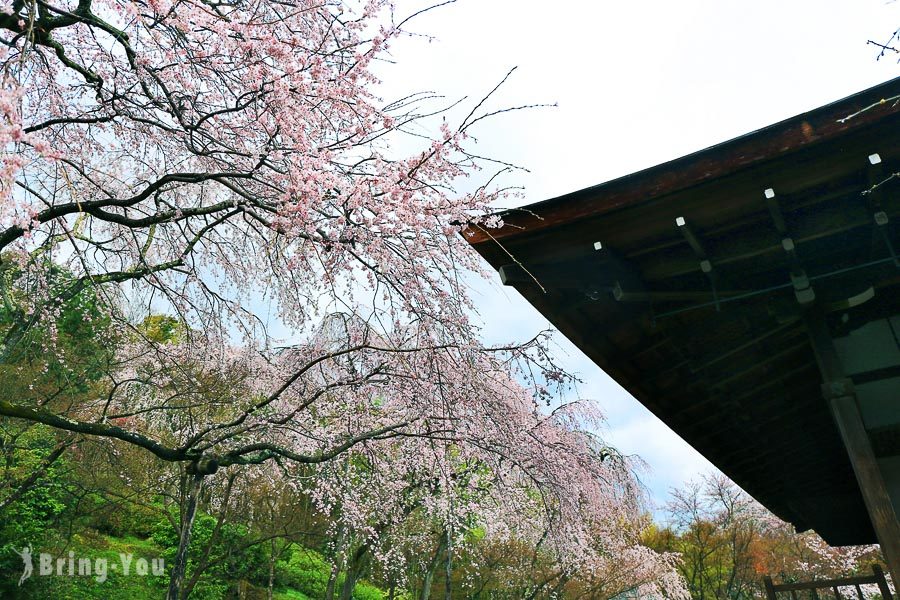
The Japanese-style garden and pond with a Zen atmosphere, coupled with the spherical Kanazawa cherry blossoms, make Baifayuan a spectacular cherry blossom viewing spot in the Arashiyama area. Although it is not the most important cherry blossom viewing spot in Kyoto, the early blooming cherry blossoms every year and one of the weeping cherry trees supported by bamboo frames are particularly impressive. It is one of the most eye-catching cherry blossom viewing spots in the Arashiyama area.
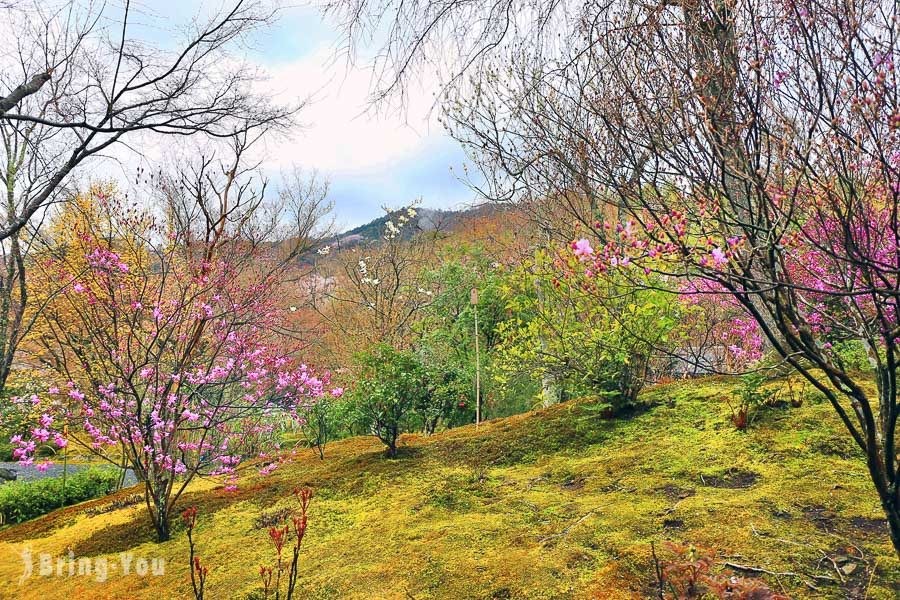
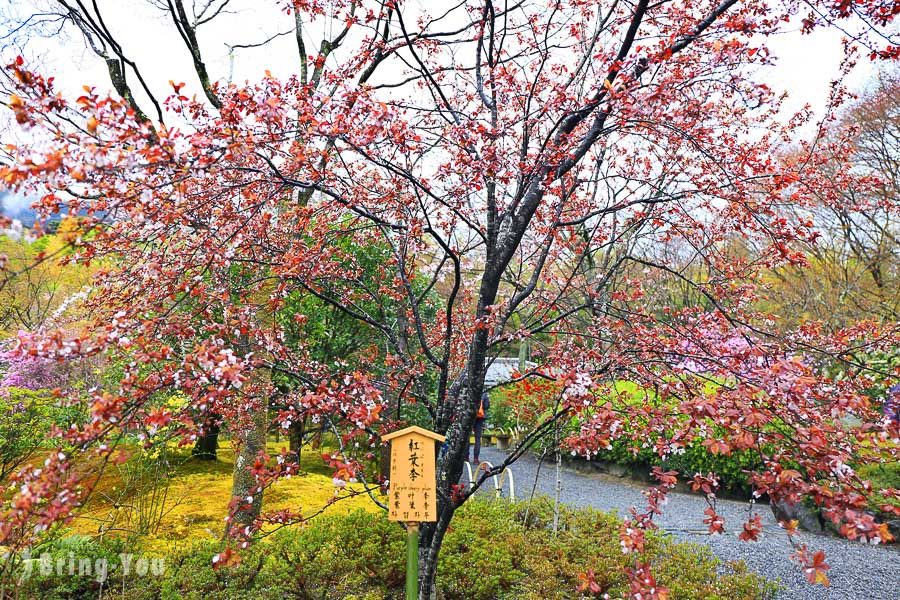
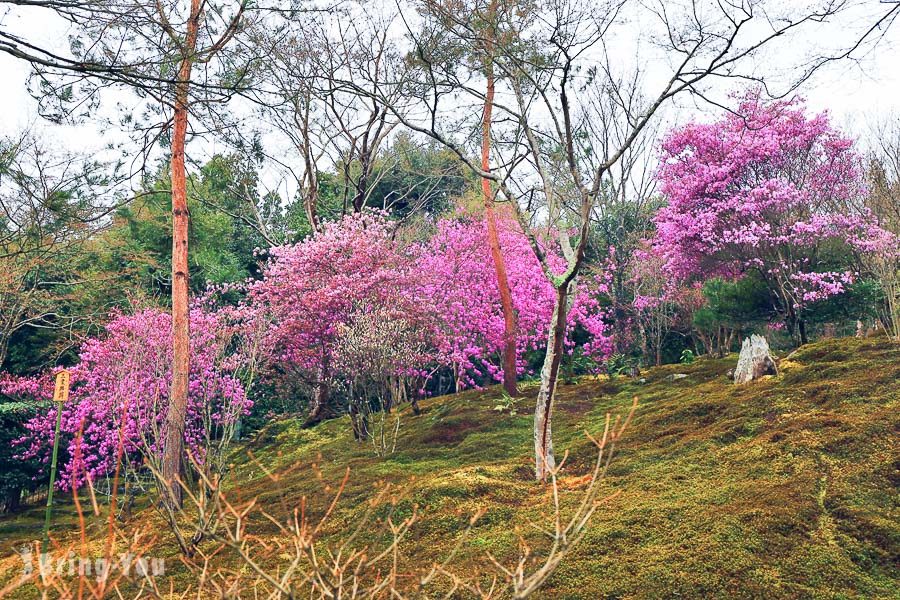
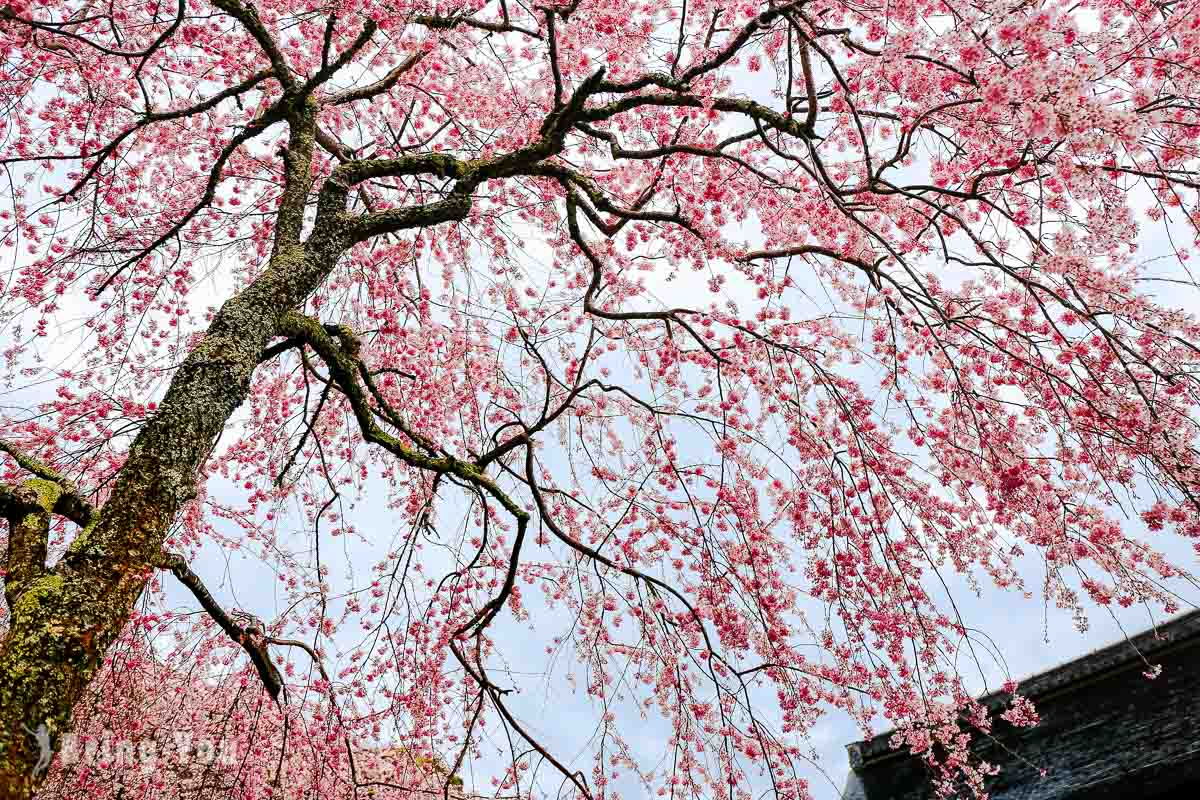
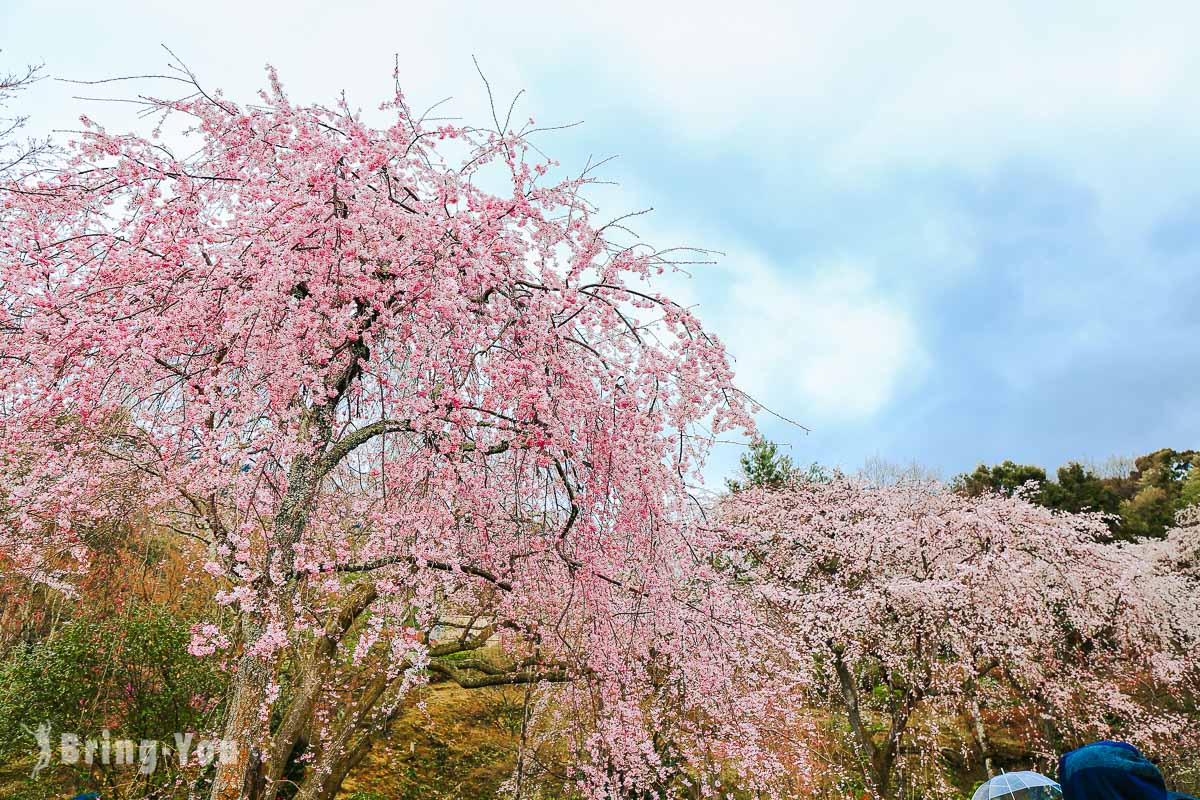
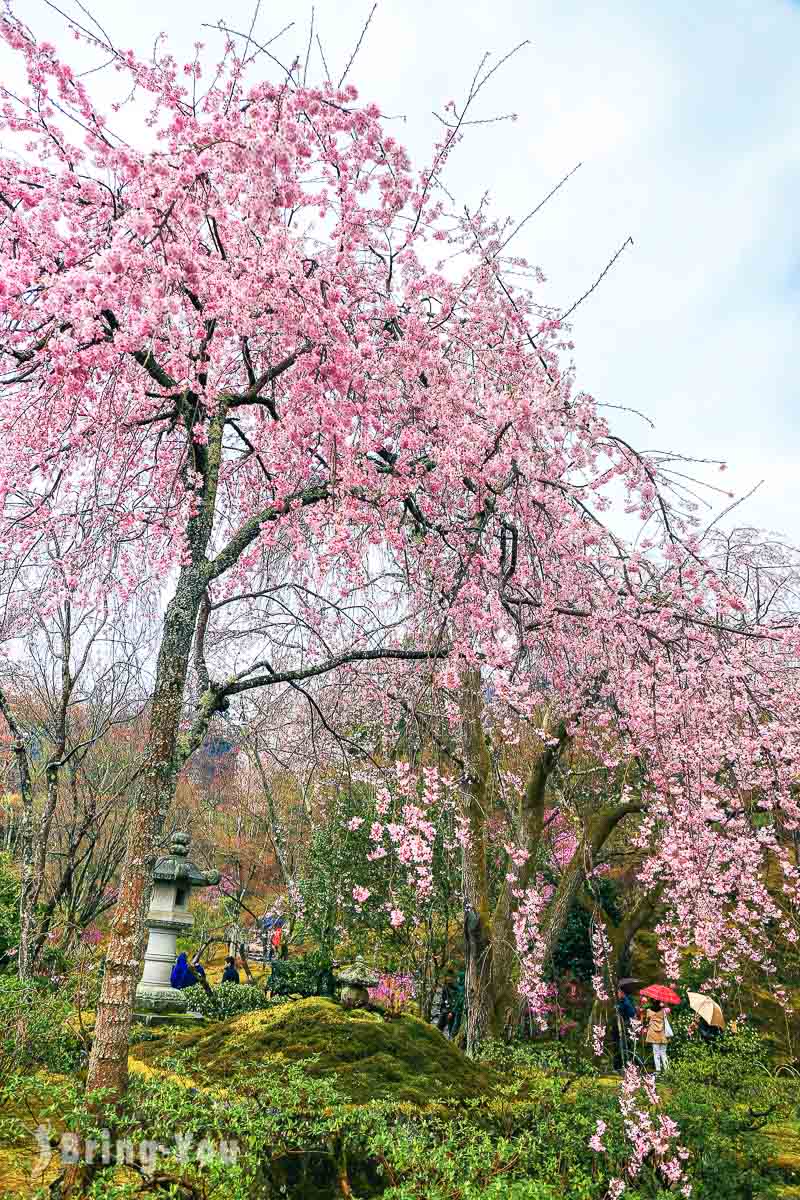
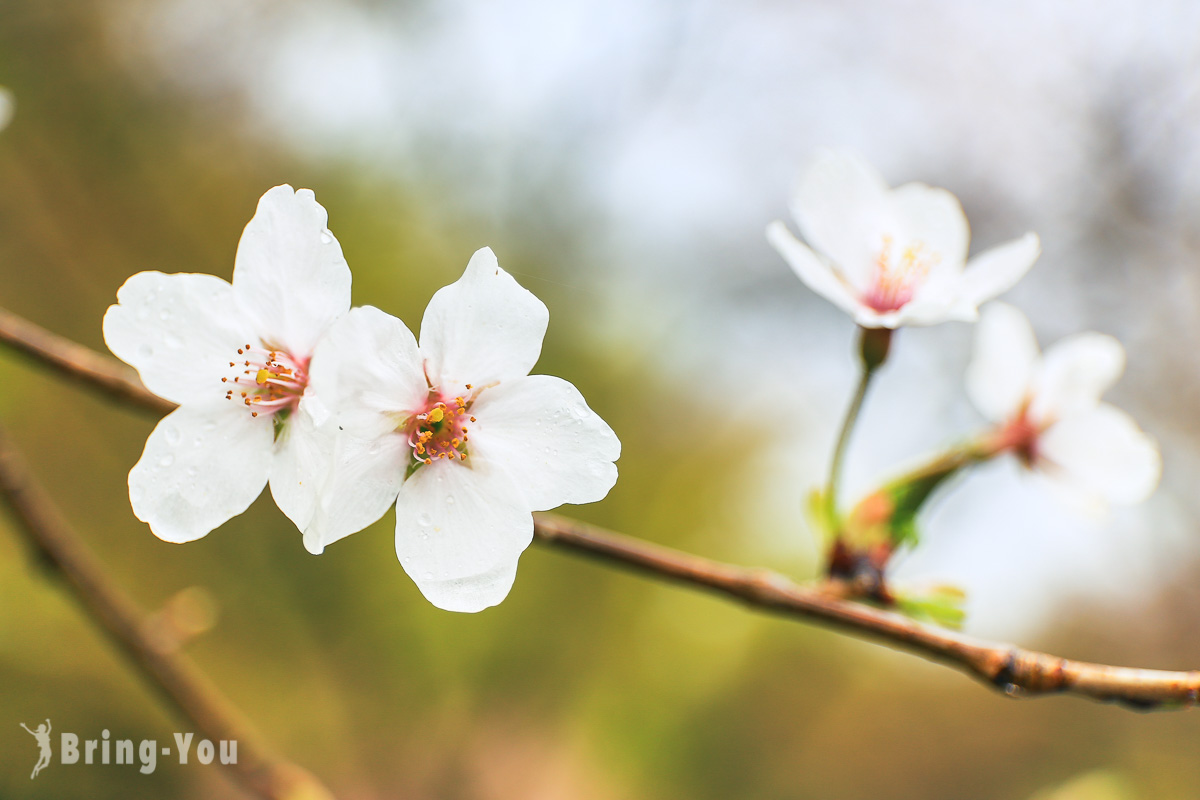
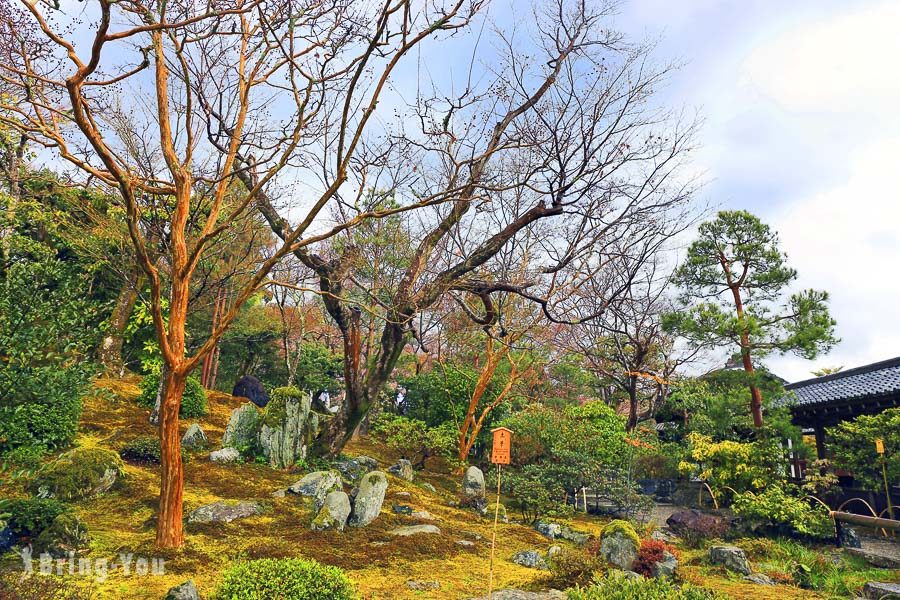
▼Sakura on the Other Shore
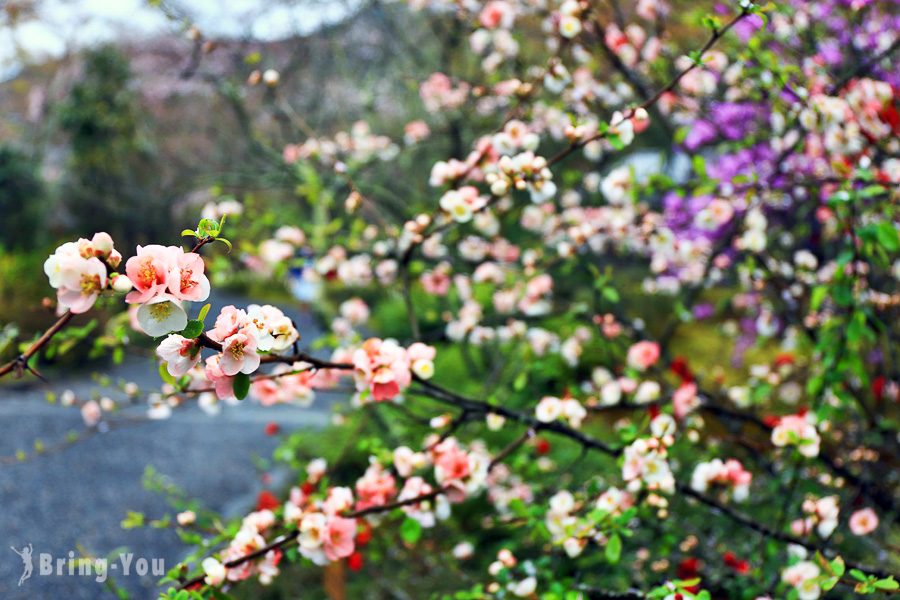
▼ Inkstone: Erected in memory of the dragon painted on the ceiling of the hodo by artist Suzuki Shonen in Meiji 32, which was believed to protect the Buddhist teachings, and the sixty monks who assisted in grinding ink at that time.
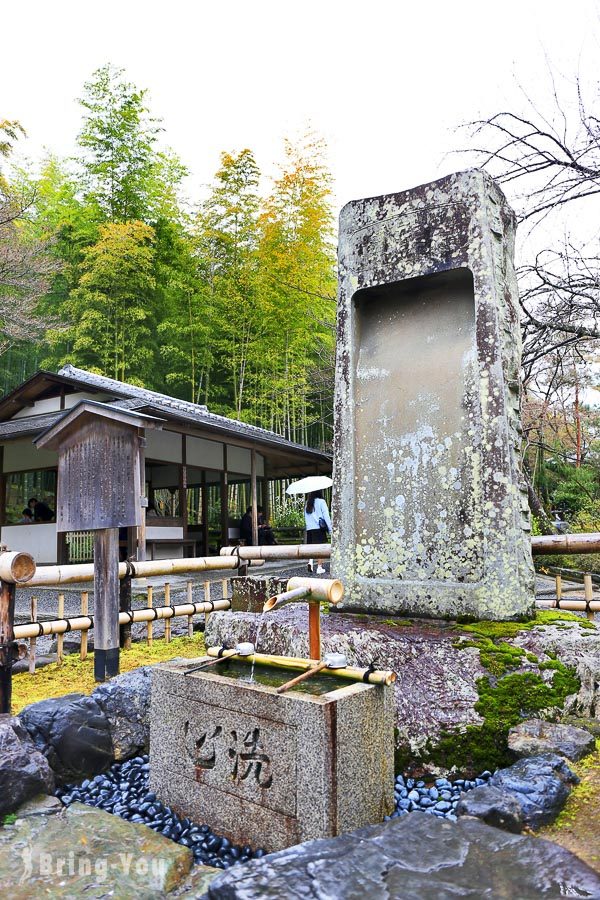
Walking up along the corridor, away from the Hundred Flowers Garden, there are fewer people here, but the garden scenery has a serene Zen feeling that I love.
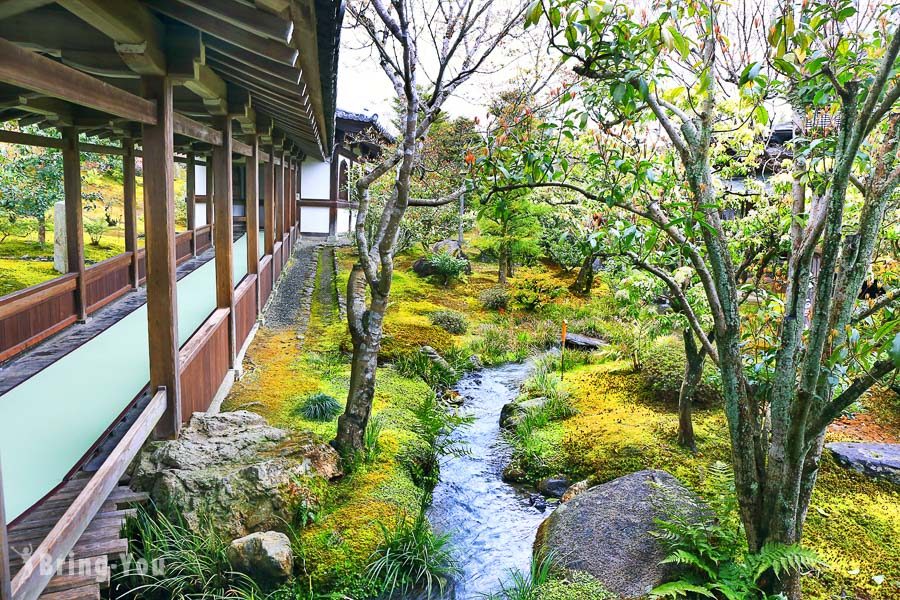
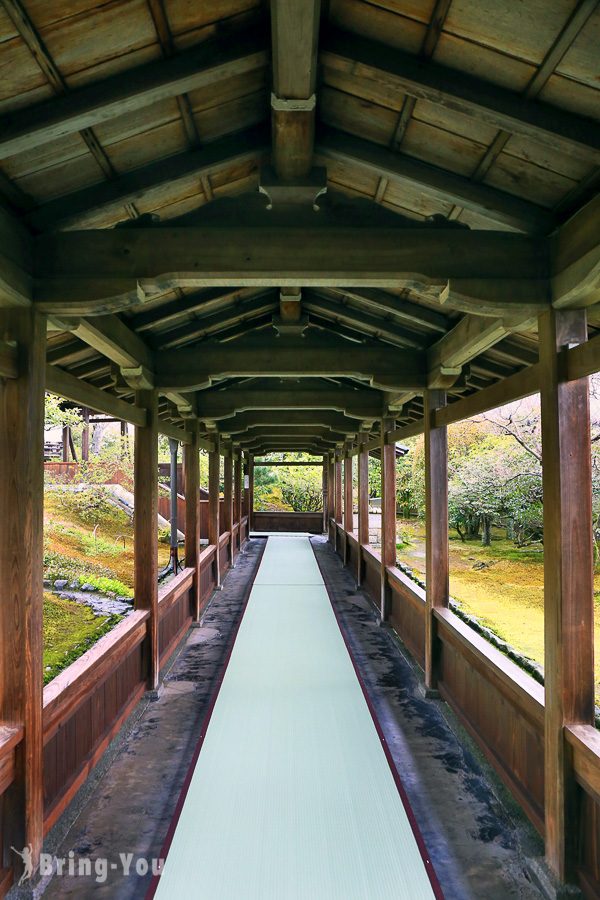
From the high point of Baihua Garden, you can enjoy the beautiful cherry blossoms of Tianlong Temple. Unfortunately, it was raining that day and many cherry blossoms had fallen. Otherwise, I think this place is really beautiful.
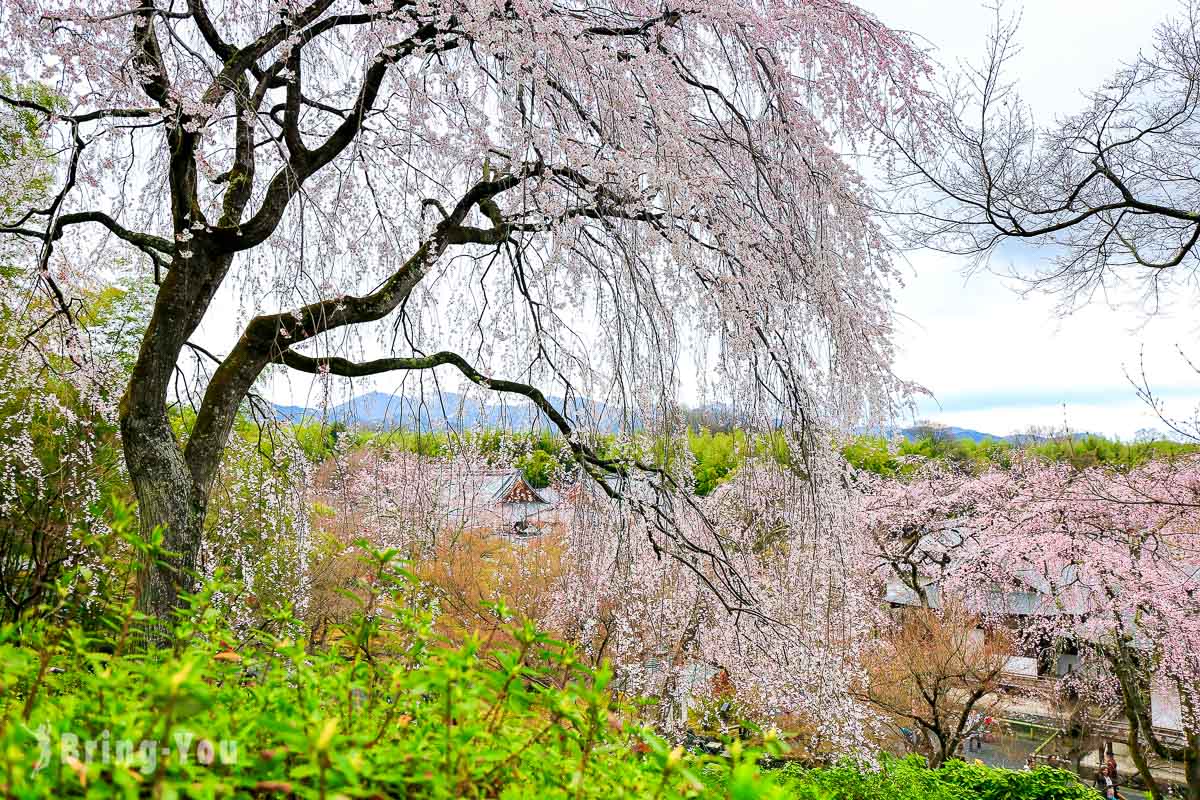
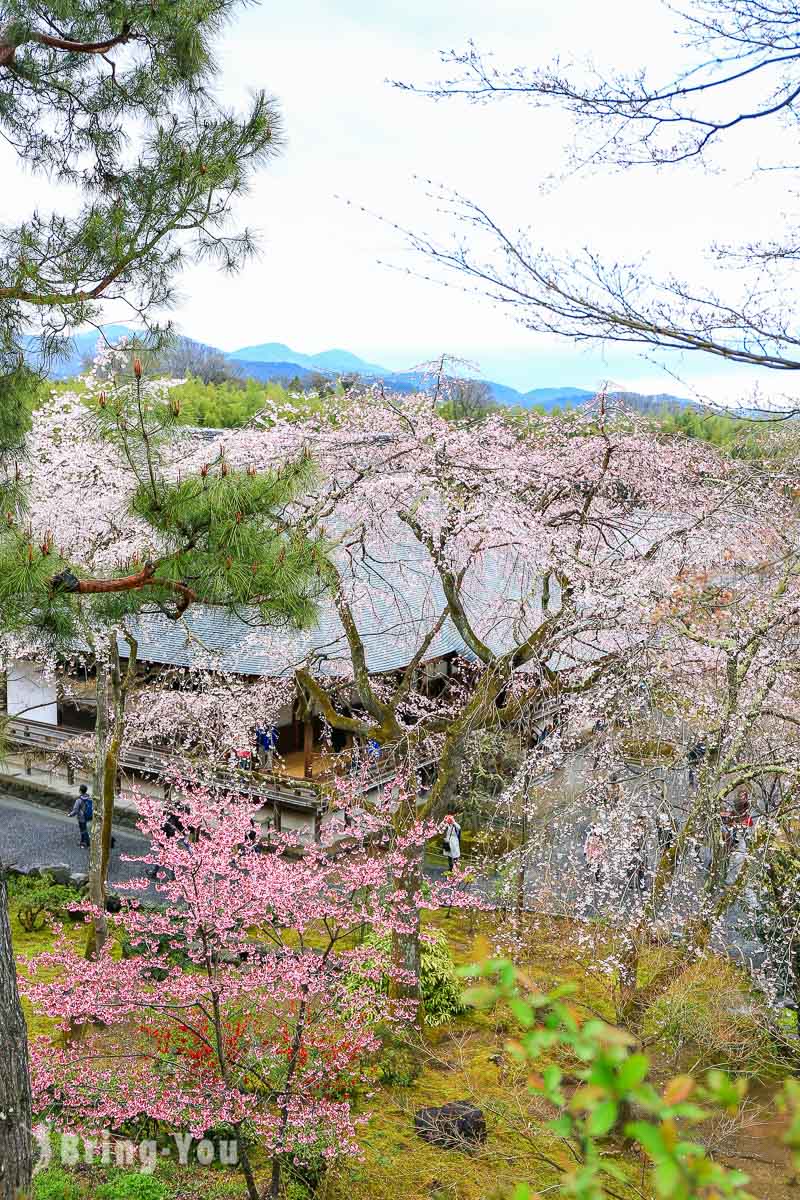
▼ Enjoy the blooming cherry blossom sea at Tenryuji Temple from a high place
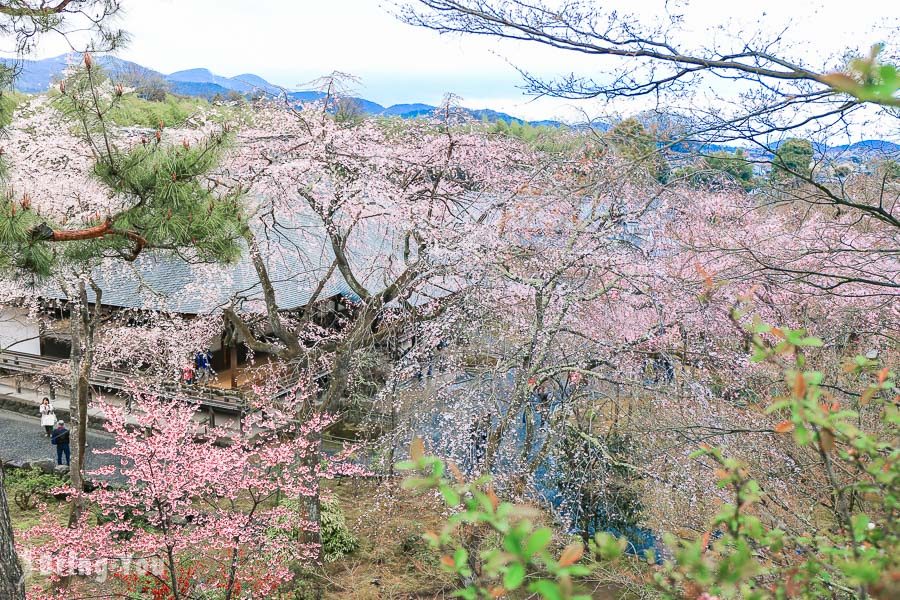
Worship at Various Halls
After finishing the tour of the outdoor garden, I returned to the entrance of the courtyard and presented my ticket to visit the various halls. Then, I entered through the entrance and saw the “Bodhidharma Statue”. As I walked towards the abbot’s room, I also saw the same Bodhidharma image, symbolizing the Bodhidharma Zen.
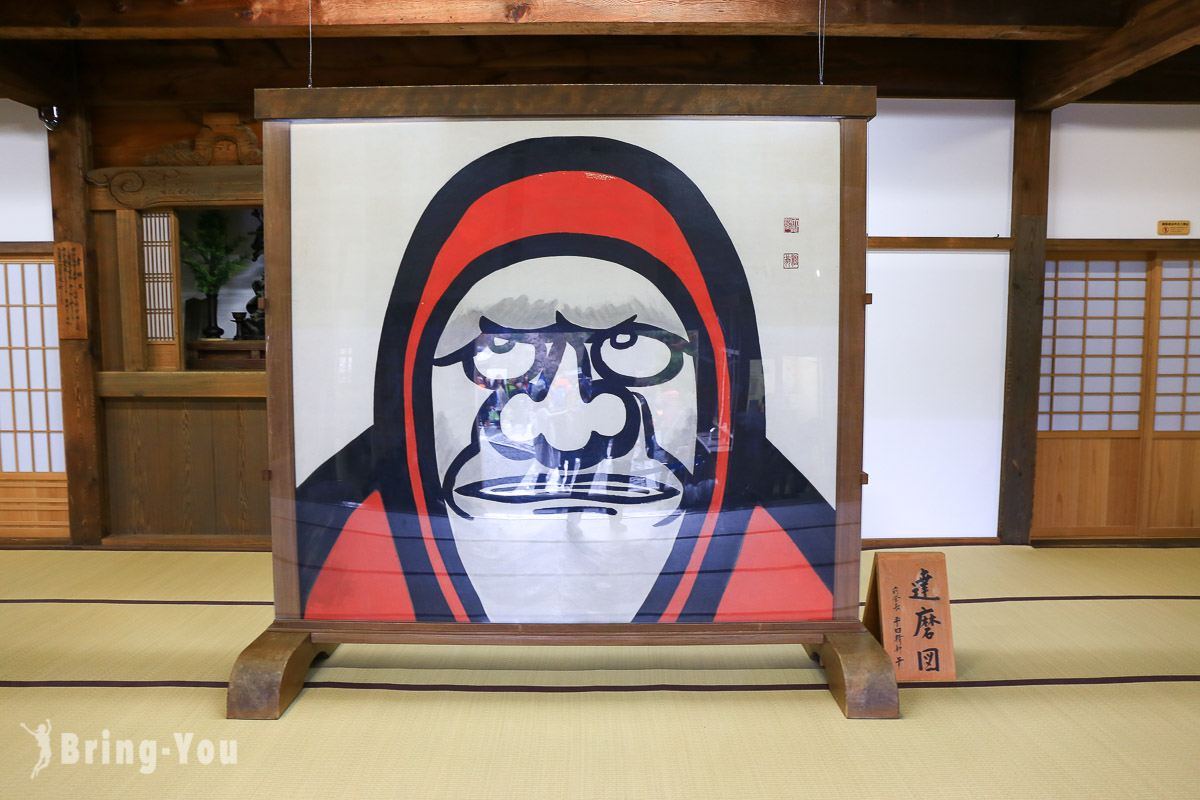
The abbot’s room has six rooms, three inside and three outside. There are 48 tatami mats in the room, with a statue of Shakyamuni Buddha enshrined.
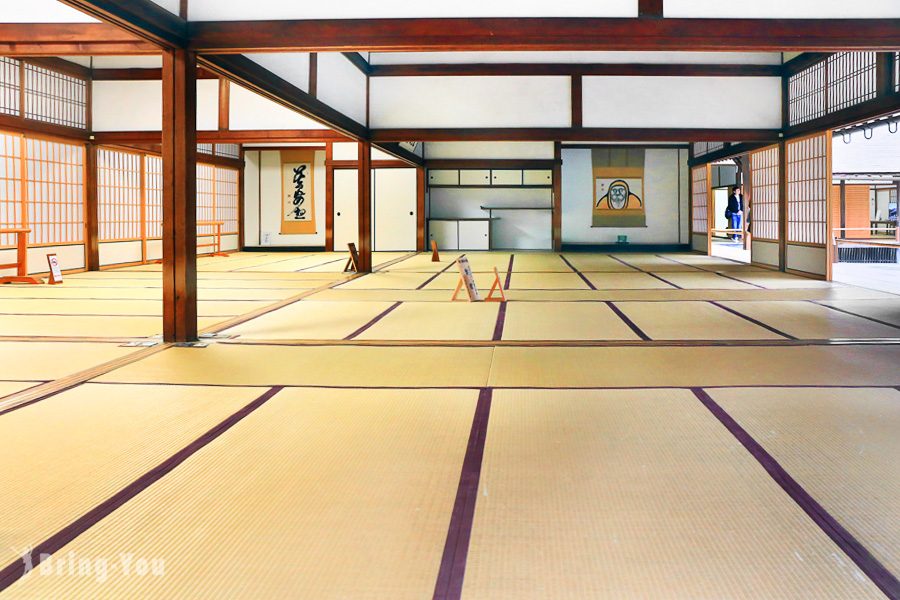
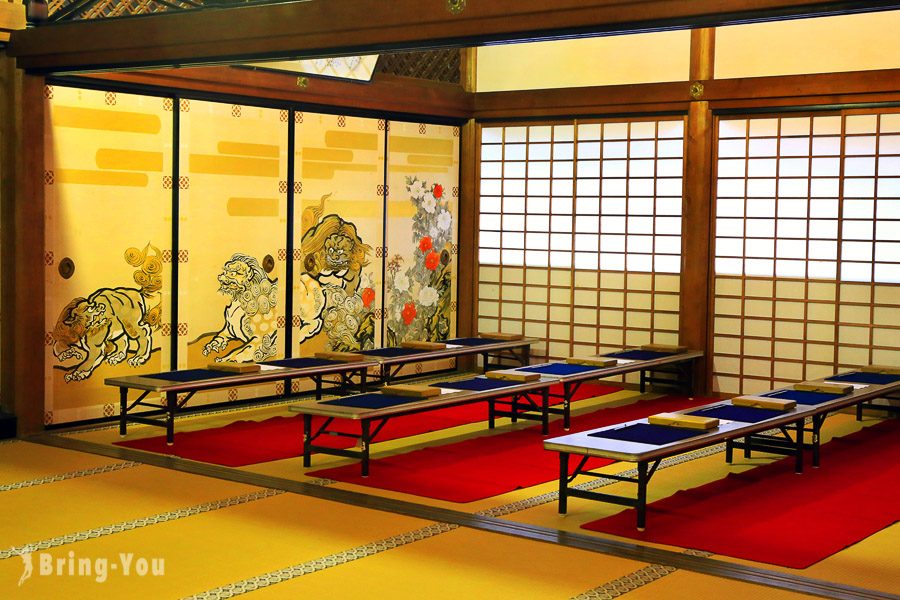
There aren’t many things that cannot be photographed inside the abbot’s room. The main thing is to walk around the corridor along the four sides and take pictures of the Cao Yuan Chi Garden. However, the scenery won’t be as beautiful as in the garden because the photos taken indoors will show people’s heads outside.
Multi-Treasure Hall
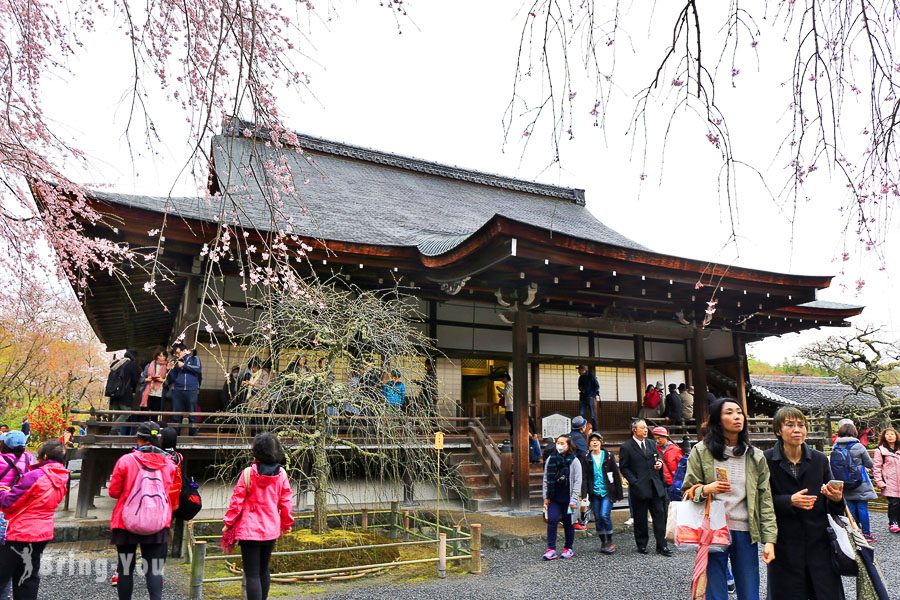
The Dabao Hall is located at the northwest end of the Abbot’s Room. Built in 1934, it features a hipped roof and a two-meter-wide altar for worship at the front of the main hall. The altar is connected to the corridor, and inside the hall is enshrined the statue of Emperor Go-Daigo.
Yunlong Painting in the Dharma Hall
Above is the introduction of the gardens and halls that can be visited together. Another independent paid area in Tenryu-ji Temple is the Hatto, where you can admire the stunning Unryu-zu (Cloud Dragon) painting, which is incredibly detailed.
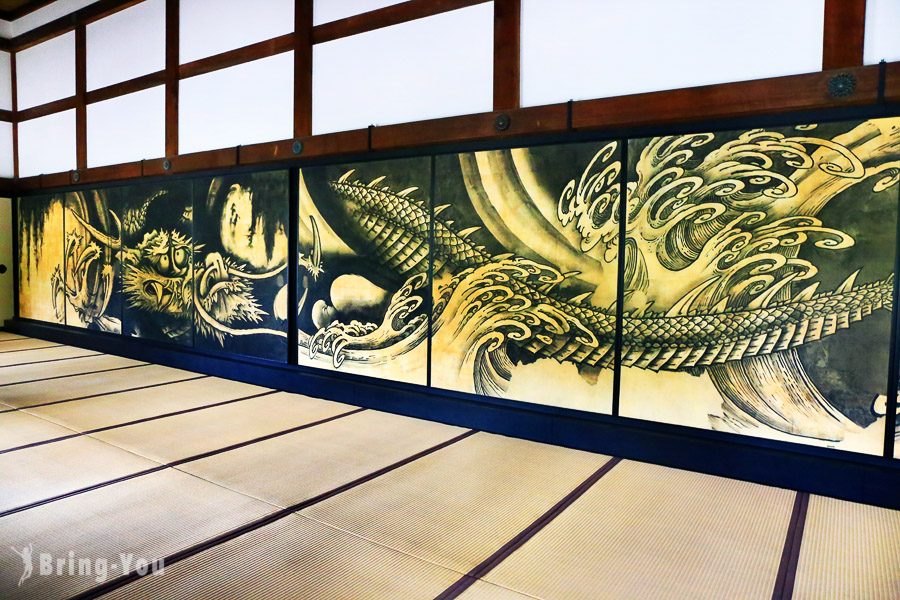
After visiting Tenryu-ji Temple, you can choose to walk through the Hyakkaen Garden and pass through the North Gate to get to the Bamboo Forest Trail, the Arashiyama Romantic Train, and Jojakko-ji Temple, or you can choose to walk through the original entrance and explore the Arashiyama Shopping Street and Togetsukyo Bridge.
- Directly to the shopping street from Tenryu-ji Temple: 【Arashiyama Shopping Street Stroll】Arashiyama Park, Sagano Bamboo Forest Trail, Food Guide
- My favorite serene spot in Arashiyama: Giou-ji Temple: A Serene, Melancholic, and Mossy Temple on the Arashiyama Trail
